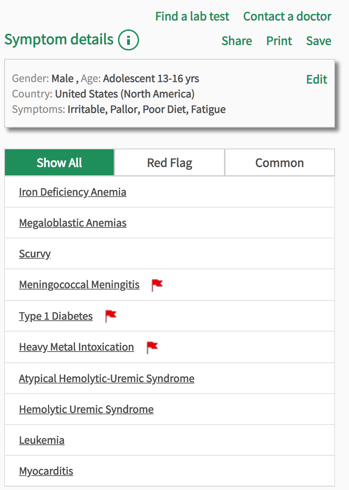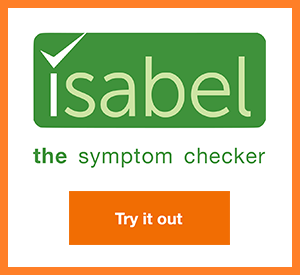- Privacy Policy
- Terms & Conditions
- Contact us
- ©Isabel Healthcare 2025
Iron deficiency anemia in infants and children - Signs and symptoms
Iron deficiency symptoms, as we explored last week in our blogpost, are common in pregnant women and in women who experience heavy periods. Another predominant age group at risk of iron deficiency symptoms are infants and children. In this week’s post we will explore how iron deficiency manifests in the under 18’s and symptoms to be aware of, which can give you an early warning that your infant or child is becoming iron deficient.
Iron deficiency is the most common nutritional deficiency in the world and iron deficiency anemia accounts for 50% of all anemia cases. Worldwide the prevalence of iron deficiency anemia is 2 billion people. Infants and children under 12 account for 4-7% of cases, men account for 2-5% and menstruating women make up 30% of these cases. In developing countries, it is even more acute and estimations in sub-Saharan Africa are 50-70% of pregnant women are anemic, 50% of pre-school children and 46% of school age children are affected by iron deficiency.
Iron and its importance in children
Iron is an essential nutrient in a child’s diet, allowing for adequate growth and development. Iron is essential to allow movement of oxygen from the lungs around the rest of body and helps muscles store and use oxygen. There are many stages of iron deficiency and symptoms can appear early on before the chronic stage of iron deficiency anemia is reached. It is possible, if you recognize the symptoms, to treat iron deficiency before it reaches the anemic stage, where iron stores have been depleted.
Iron deficiency in different ages of children
Infants under 1
Infants who are born prematurely (more than three weeks early) or have a low birth weight, are at risk of iron deficiency and a doctor may recommend iron supplements if this applies to your infant. If your infant is breastfed they should have an adequate supply of iron from breastfeeding until they are at least 4 months of age. After this time, an iron supplement may be needed if the infant is exclusively breastfed, until they start to take other foods in their diet. The American Academy of Pediatrics recommends infants are exclusively breastfed for the first six months. It is not recommended that infants are given cow’s milk if they are under 1 year of age, as cow’s milk at an early age can decrease the amount of iron absorbed by the gut. If a baby is formula fed, choose a formula which is fortified with iron to prevent iron deficiency anemia.
Toddlers and preschoolers (age 1-5 years)
Cow’s milk is low in iron and after 1 year of age you should ensure a child doesn’t drink more than two cups of cow’s milk a day. If a child drinks too much cow’s milk then they can become full easily and not eat other foods to complement their diet, resulting in iron deficiency. If a child has a balanced diet of other foods as well as fluids then they should receive enough iron from their diet.
A child with a diagnosed health condition which causes their diet to be restricted may become iron deficient. This can be due to the health condition itself or repeated infections, and so an iron supplement may be prescribed by their health provider.
School age children (age 6-12 years)
If children are picky eaters or they are on a vegetarian diet then they may not obtain enough iron from their diet and become iron deficient. In the case of vegetarians, iron rich vegetables such as spinach can be a solution, as well as supplements.
Adolescents
Iron deficiency is noticeably seen in adolescents due to the periods of rapid growth that they undergo, and iron stores can become easily depleted. Girls are particularly affected during adolescence as their bodies are not able to store as much iron and they lose iron during menstruation. Adolescent boys can also be affected if their diet is poor and due to the rapid growth they undergo at puberty.
Symptoms of iron deficiency in children
A child who is not receiving enough iron from their diet or who has other complications from their health will become anemic if the iron deficiency is not recognized and corrected. When there isn’t enough iron in the body then fewer red blood cells are made and anemia results. What’s more, when iron stores are depleted, the body uses up the limited iron it has available to try and maintain the red blood cell count that keeps vital systems functioning in the body, but as a consequence other muscle and brain functions can be affected.
Look for these signs of iron deficiency symptoms in your child and use the Isabel Symptom Checker if you need to make sense of these symptoms:
- Fatigue and weakness
- Pale skin especially around nails, hands and eyelids
- Slow growth and development
- Poor appetite
- Rapid breathing (tachypnea)
- Headache
- Fast heart rate (tachycardia)
- Behavioral problems
- Recurrent infections
- Rough skin
- Alopecia and damaged hair
- Unusual cravings for substances such as ice, dirt, paint or starch (pica)

Symptoms of Iron Deficiency in Adolescents
It should also be noted that mild cases of iron deficiency may be asymptomatic, with no signs or symptoms present. If you are concerned about iron deficiency then look for subtle signs and examine your child’s diet and intake. Keeping a food diary may help you assess their diet.
Pica is an interesting symptom which may show in iron deficient children. Children with low levels of iron may develop cravings for non-food items including ice, dirt, clay, paper, cardboard and cornstarch. Pica can cause constipation and if your child develops a craving for these types of items then they should be reviewed for iron deficiency.
Iron deficiency can affect a child’s ability to learn or focus, and affect their energy. Severe iron deficiency can result in sustained developmental problems, so being aware of iron deficiency and its manifestations in your child can help you decide when supplemental iron is required and to recognize symptoms where you child may be iron deficient.
If you are concerned about your child's symptoms or suspect iron deficiency, place all the symptoms into the Isabel Symptom Checker and discuss the results, and possible treatments, with your doctor.

Mandy Tomlinson
Mandy has worked for Isabel Healthcare since 2000. Prior to this, she was a Senior Staff Nurse on the Pediatric Infectious disease ward and high dependency unit at one of London's top hospitals, St Mary’s in Paddington which is part of Imperial College Healthcare NHS Trust. Her experience in the healthcare industry for the past 33 years in both the UK and USA means she's a vital resource for our organization. Mandy currently lives and works in Scottsdale, Arizona.
Subscribe Here!
Recent Posts
Isabel DDx Companion with ChatGPT Integration - to help you diagnose even faster
At Isabel Healthcare, we’ve always been driven by one goal: to make clinical reasoning faster,..Virtual Triage: Do more questions lead to better patient outcomes?
One of the common misconceptions related to virtual triage / symptom checker tools is that the more..List Of Categories
- Differential Diagnosis Decision Support
- Differential diagnosis
- Symptom Checker
- Symptoms
- Medical Error
- Patient Disease Information
- Disease
- Clinical Decision Support
- Diagnostic Decision Support
- Isabel 1 Minute Read
- Diagnosis Error
- Diagnosis Skills Cases
- Healthcare Informatics
- Clinical Reasoning
- Evidence-based Medicine
- Medical Education
- Patient Engagement
- Symptom Triage
- Nurse Practitioner Education
- Nursing Decision Support
- Partnership
- Public Health
- COVID-19
- EHR
- Patient Empowerment
- Patient Safety
- rare disease

Start your FREE Trial today
Try the Isabel Pro DDx generator for 30-days - no payment card details required.




